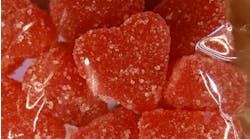Sometimes the pursuit of a clean label leaves something to be desired in the flavor department. That’s where flavor enhancers come in – as long as they, too, are considered “clean.”
Yeast extracts and monosodium glutamate may have their detractors, but they have a long and safe history as flavor enhancers; and they should be considered natural, according to Joseph Formanek, director of new product development in the customer application center of Ajinomoto Health & Nutrition North America.
Yeast extract and dried yeast impart umami, that "pleasant savory taste" that was recognized as the fifth taste in the 1980s – while also enhancing the four traditional tastes. Most umami comes from foods that are high in the amino acid glutamate – products such as Parmesan cheese, mushrooms and seaweed.
“Yeast extract is high in glutamates and nucleotides,” says Formanek. “The mouth has receptors for glutamic acid, the most common amino acid, and that imparts umami.
“Nucleotides by themselves do not impart much umami, but in the presence of glutamates, they amplify the umami sense and response,” he adds.
Kokumi is another Japanese term that’s worked its way into the culinary lexicon. While not quite recognized as a taste, the sensations of mouthfulness, heartiness and thickness it imparts enhance the five tastes. It invokes the satisfying experience of butter, fats and emulsions coating the tongue and mouth.
“Just like umami, the proteins break down into peptides, but the receptors for peptides deliver a sensation of richness, body, complexity,” says Formanek.
Ajinomoto’s main flavor enhancers are the Savorboost line of products. Savorboost U delivers just umami; Savorboost K delivers kokumi; Savorboost F (full) delivers both.
All the Savorboost products can be labeled “natural” (one has maltodextrin, which some product developers may question), and they show up on the ingredient statement as yeast extract.
While most of the emphases for these products are on flavor enhancement, “they also can be used for cost reduction,” notes Formanek. “You can use less of the beef, cheese or whatever the costly ingredient is because the taste is heightened.”
Boosting saltiness
With consumer interest in lowering sodium intake, ingredients that enhance the “saltiness” of a product are another major category of flavor enhancers. Salt and its replacements don’t just add salty flavor; they also make sweet flavors stronger and bitter flavors less bitter by suppressing bitter flavor compounds in foods.
SensaSalt 2G from Sensient Flavors is another yeast extract, but one used to enhance the perceived saltiness of formulations that reduced sodium. “It’s a blend of yeast extracts that label as ‘natural flavor’ and is considered a clean-label solution,” according to Roger Lane, marketing director of Sensient Flavors.
It’s used in a variety of applications where less sodium is desired. The product “enhances a wide variety of positive flavor attributes in a full range of lower sodium products, while negative flavors are diminished,” according to company literature. “Sensory studies have shown SensaSalt 2G even outperforms sodium when tasted side by side.”
Potassium chloride has long been used as a salt substitute, because of its salty flavor. But it is usually mixed with other flavors to balance out the unpleasant aftertaste.
“Some sodium replacements are a blend of sodium and potassium chloride to balance out the negative effects,” says Amy Usiak, a business partner and R&D lead for food industry consulting firm JPG Resources. “If it’s a savory product and not sweet, lots of times they include less salt and add other spices, such as a super low level of garlic or onion seasoning. That gives you a nice background note.”
Another trend in salt-related flavor enhancers is the use of better quality sea salt in processed food. For example, sea salt products from SaltWorks are enhanced to bring out characteristics desired by manufacturers.
Most SaltWorks products are available in several grain sizes. “Our powder grain is the consistency of baking flour and therefore dissolves quickly,” he says. Mark Zoske, founder and CEO of SaltWorks.
“Our Pure Ocean Premium Sea Salt is the only all-natural ingredient sea salt currently offered in snack grain size (i.e., extra fine). We specifically designed it for optimal adherence on snack food products with the advantage of a slightly larger granulation adding texture and visual appeal. It’s perfect for packaged pretzels, pita crisps, crackers, tortillas and tortilla chips, soups, sauces, nut or trail mix blend, etc.”
Mellow malic
Malic (apple) acid is an acidulant that is naturally present in all fruits, usually in combination with citric acid, where it enhances fruit flavor and sourness. Formulators have long used malic acid in the food & beverage industry for its many flavor characteristics.
“Malic acid’s mellow, smooth and persistent sourness enhances the sensory experience of a variety of applications,” says Mohammad Emami, senior product manager at Bartek Ingredients, Stoney Creek, Ontario. “From aroma to intensity to depth of flavor, many foods and beverages can achieve a better flavor experience, be it related to aroma, intensity, depth of flavor, or aftertaste.
Emami says malic acid’s attributes include:
- Intensifying the impact of many flavors in foods or beverages, often reducing the amount of flavor needed
- Blending distinct flavors, resulting in a well-rounded flavor experience
- Improving aftertaste by extending the impact of some flavors
- Increasing burst and aromaticity of flavor notes in certain beverage applications
- Boosting savory flavors, like cheese and hot peppers, in snack food coatings
- Deepening and broadening flavor profiles of many products for a richer and more natural flavor experience
- Improving the sweet/sour balance and flavor profile of many products that include high intensity sweeteners
“Bartek’s malic acid blends with other food acids, sugars, high-intensity sweeteners, flavors and seasonings to provide the most ‘true-to-fruit’ flavor experiences in foods, beverages, confections and more,” Emami concludes.
Sweet with less sugar
Clean-label flavor enhancers that affect the sweetness of a product are attractive in today’s market because so many consumers are seeking to reduce the amount of sugar they eat. Sugar itself can be considered clean-label, since it’s a natural ingredient, but consumers want less of it.
Besides being a wonderful flavor on its own, vanilla is an ingredient that can be added to enhance sweet flavor without more sugar. Vanilla has a “nuanced flavor and aroma” that complement and heighten flavors and ingredients it’s mixed with.
Vanilla was Virginia Dare’s foundation, but the company has grown beyond vanilla to encompass many ingredients, flavors and systems. In its Taste Improvement platform, “Our solutions for flavor creation and taste refinement add characterizing flavors, mask off-notes and fine-tune specific taste attributes,” the company says.
“We improve taste with customizable, integrated taste refinement systems for masking and modulation. Masking systems selectively mask off-tastes and undesirable taste attributes including acidity, aftertaste, astringency, bitterness, chalkiness, harshness, medicinal, metallic, and saltiness. Our taste modulation solutions are designed to fine-tune specific taste attributes, such as sweetness perception and overall flavor impact.”
Many clean-label flavor enhancers derived from plants do not fall into the sweet or salty category; they are used to impart other flavors or to affect mouthfeel.
Spirulina, for example, is derived from cyanobacteria and is sometimes added to processed food for color and flavor enhancement.
“Blue spirulina contrasts with chocolate, so it complements the flavor when it’s in the right balance,” says Suzannah Gerber, executive director of food consulting firm Haven Foods. “And you end up with blue chocolate.”
Turmeric is another such additive. It is mainly used to impart a yellow color, but it also affects the overall experience of eating the product.
“Turmeric comes alive when you pair it with fat,” Gerber notes. “It’s astringent, earthy and a bit on the warming side. When you pair it with coconut milk, it adds complexity and depth and coats the mouth.”


